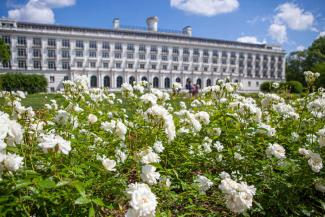Kemeri is an area of the Jurmala seaside town where a resort was set up already in the 18th century due to the therapeutic qualities of sulfur water in the many springs in the neighborhood. Only architectural monuments are left to speak of the former glory of the Kemeri resort, although sulfur water and mud are still available.
Kemeri is a half-an-hour ride away from Riga. The area is quiet and peaceful, perfect for a family outing.
Attractions in Kemeri
Kemeri Landscape Park. The park was created in the middle of the 19th century and features a network of winding paths interspersed with architectural objects – pavilions, rotundas, bridges across the artificial canals fed by the Versupite River that flows through the park. The Sulfur Water Pavilion, built at the turn of the 19th and 20th centuries, stands in the south-eastern part of the park. Next to it, you will find the Kirzacina (Little Lizzard) sulfur spring, one of the most popular in Latvia. Its water can be used both internally and externally. Other interesting objects in the park include the Love Islet Pavilion, a rotunda built in 1928 in the Classicism style; the Russian Orthodox Church of the Holy Apostles Peter and Paul, the oldest of the churches in Kemeri which was built in 1893 in the style of wooden churches typical for Northern Russia; monuments to the founders of the Kemeri resort, the first physicians, who worked there, and soldiers fallen in World War I and World War II.
Former Kemeri Hotel. The hotel was designed by the outstanding Latvian architect of Baltic German descent, Eizens Laube (1880–1967). The white building is a brilliant example of Neo-Classicism in the Latvian architecture. The majestic outline of the building earned it the nickname of the White Liner rich in the elements of Classicism – columns, balustrades, pilasters and cornices. Effectively positioned in the landscape park, the massive building assumes the air of a palace. In the late 1930s, the Kemeri was one of the most modern hotels in Europe and could accommodate over 100 guests, offering therapeutic services not only during the summer season but all year round. During Soviet times, the hotel was transformed into the Kemeri Sanatorium with rooms for 300 patients. It was the main health facility in the area and used advanced medical equipment and the latest therapeutic methods. At present visitors can admire the White Liner only from the outside.
History of Kemeri resort
The sulfur springs of Kemeri were used in traditional medicine already in the second half of the 18th century and in the early 19th century when the ailing noblemen of the Kurzeme region came here for treatment and stayed with local foresters. The chemical analysis of Kemeri spring waters was first carried out in St. Petersburg in 1801.
The first public bathing establishment in Kemeri was built in 1838 on a state-owned plot of land that had been allocated for sulfur water therapy purposes by Emperor Nicholas I. This is regarded as the year of founding of the resort which was quite popular in the Russian Empire, and a direct railway line between Moscow and Kemeri was opened in 1921.
During World War I there was active fighting in the area of Kemeri and Tirelpurvs, and the resort suffered serious damage. But it recovered quickly after the war and was granted the status of a town in 1928. Similar to Sigulda, Kemeri was a favorite among holiday-makers from Riga.
The electric train line to Kemeri was opened in October 1951. In 1959 Kemeri became part of the Jurmala city. During the Soviet times the resort was significantly expanded and given the status of a resort of the USSR importance. But the flourishing resort went into the decline in the 1990s when the economic situation changed after restoration of Latvia’s independence.
Location and sights nearby













